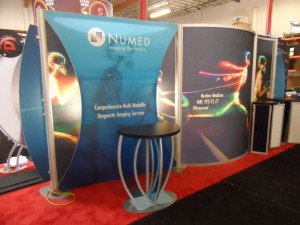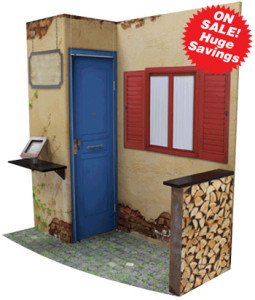What Message Does Your Trade Show Booth Send?

Custom VK-1232 Sacagawea portable hybrid trade show display with tension fabric and round standoff graphics
When you’re putting together new expo displays, every element to your booth – from the walls to the flooring – is ultimately “sending a message” to your visitors, whether you’re entirely aware of that message or not. Even the physical materials you use within your trade show booth can have subtle psychological effects on visitors.
While these may only have mild effects on your lead generation, they can still help refine your booth and put you “on-message.” As an obvious example, a company promoting itself as eco-friendly would not want to use a lot of traditional plastics or rare hardwoods. It runs opposite to their message.
Often, when you’re looking for clues as to why a trade show booth design seems particularly well “put together” and consistent in its messaging, those clues lie in their interior design and materials choices.
So, while perhaps it’s not the most exciting topic, today let’s talk a bit about the different materials you might put in your booth, and the messages they send.
Shaping Your Environment For Maximum Trade Show Impact
I. Wood
Wood is, of course, probably the oldest building material in use, and it still has a powerful effect. Wood is warm and inviting, as well as being easy to work with. When properly treated, it’s also easy to clean. Wood flooring, for example, can be reused over and over.
Since most woods are relatively lightweight, storage and transportation aren’t as big an issue – although they need more space than folding plastics or cloth.
Wood works best in combination with the “earth-tone” colors, but will look out of place in most modernist settings. Because it’s old-fashioned, wood is probably not a good choice for high-tech or industrial displays.
Keep in mind the source for your wood: stick to sustainable sources, or quickly-growing plants like bamboo. (Right now, bamboo screams “We’re a green company!”) Rare woods that are hard to grow, like Mahogany, will turn off a lot of eco-conscious visitors, and are probably only appropriate for high-end luxury products.
For traditionalist looks, or a touch of class, wood decorations are a great touch. Look to combine them with colored light, since it bounces off wood in interesting ways.
II. Metal
Metal in trade show construction is largely utilitarian. If you’re mounting large displays, rows of display lights, or hanging elements from the ceiling, you’re almost certainly going to end up with metal all over the place.
To a certain extent, visitors overlook these elements when they’re clearly functional in nature. Few people would complain about the ugly scaffold holding up your lights.
That said, if you’re going to need a lot of metal, you might as well make that a main motif so that your main booth doesn’t “stick out” against all the framework. Trying to create a cozy Japanese-influenced space with shiny trellises everywhere probably will not work.
You could also use fabric to cover up the metal, if you worry it will be a distracting eyesore.
Try to stick to aluminum unless you truly need to do heavy lifting. Aluminum is extremely lightweight for its strength, and is one of the most commonly-recycled metals. If you’re contemplating a setup that would require steel to hold it up, remember that you’re now looking at VERY expensive shipping and setup costs.
III. Stone
Speaking of “too heavy,” is it ever worth using stone in your trade show booth construction? Maybe.
Obviously, stone has its place in interior decoration. If you do counter tops, you’re going to want some granite and marble on-hand. And stone construction is heavy, sturdy, and reliable. It would say the same things about your company versus your competition.
Also, “naked” concrete walls are great for making an urban / industrial look, such as for upscale clothing or art displays. This takes attention away from the wall -by being drab- so that everything else looks more striking by comparison.
That said… much of the time, you can just fake it. Relatively few people will be punching your wall to see if it’s “really” concrete. A plastic or cloth overlay printed to look like stone will create the same visual effect, and nearly the same emotional impact, while being vastly easier to transport and set up.
(Just keep your lights away from the walls, since the different reflective properties will destroy the effect for people who notice.)
Stone is a powerful material that sends a powerful message, but you’ll being a paying a lot for any that you have to haul into a trade show.
IV. Cloth
The advantages to fabric graphics are easy to see from a price perspective: It’s cheap, easy to produce, incredibly simple to transport, and can be printed to look like virtually anything.
As I mentioned above, you can often use cloth to “fake” other materials, in situations where people won’t be looking too hard. (Consider a cloth ceiling! Most people don’t look up much.)
Also, cloth is about as eco-friendly as you can get, so it’s great for creating low-impact displays that promote minimalism and accommodation in materials usage.

VK-2934 Visionary hybrid custom trade show display with backlighting, storage, fabric graphics, and a mod-1221 counter
On the other hand, the characteristics of cloth can play against you, from a psychological perspective. Especially at low- and middle-range trade shows, the majority of booths may be draped in cloth, making it hard to stand out. It’s also difficult to do anything truly special with cloth walls or decorations, since the limitations of the medium are well-known.
Plus, ripping and tearing are an issue. Cloth can be fragile. All it takes is one lightly-toasted attendee tripping up, and you have a wrecked display with no good way of patching it. This would, of course, severely impact the ongoing effectiveness of your booth design.
V. Plastics
While other opinions may vary, to my mind, plastic is best used and not seen. It’s plain, it’s often ugly, it’s utilitarian, and unless you’re using unconventional sources, it tends to send an anti-environmental message.
There will undoubtedly be plenty of plastics involved in your trade show booth construction. Just try to keep it out of the spotlight and covered up by other materials when possible.
It’s also the polar opposite of stone or wood in that it’s deliberately fake and artificial, which is rarely a good message for trade shows.
That said, you could look to use small pieces of plastic as decoration. Think about 60s-70s futurism in film and architecture, and their use of colored plastic to create interesting lighting effects. Especially modernist firms could also get milage out of plastic as a primary material, but think seriously about finding green sources for it if you’re doing a lot of plastic work.
Otherwise, it’s just so commonplace that it’s hard to use in large quantities without bringing the feeling that there would be better / more attractive options.
What OTHER Messages Does Your Expo Booth Send?
While it’s easy to get overwhelmed in the details when planning your next trade show display, it’s vital to remember that everything sends a message to your visitors. Your choice of materials will be perceived as deliberate, even if in reality you didn’t pay much attention.
Thoughtful use of materials lead to more unified and cohesive trade show booths, which ultimately boost your outreach and brand awareness.
Not sure what “look” is right for your next trade show display? Contact our experts for a free consultation, and we’ll make sure ALL your messages are on-target!

